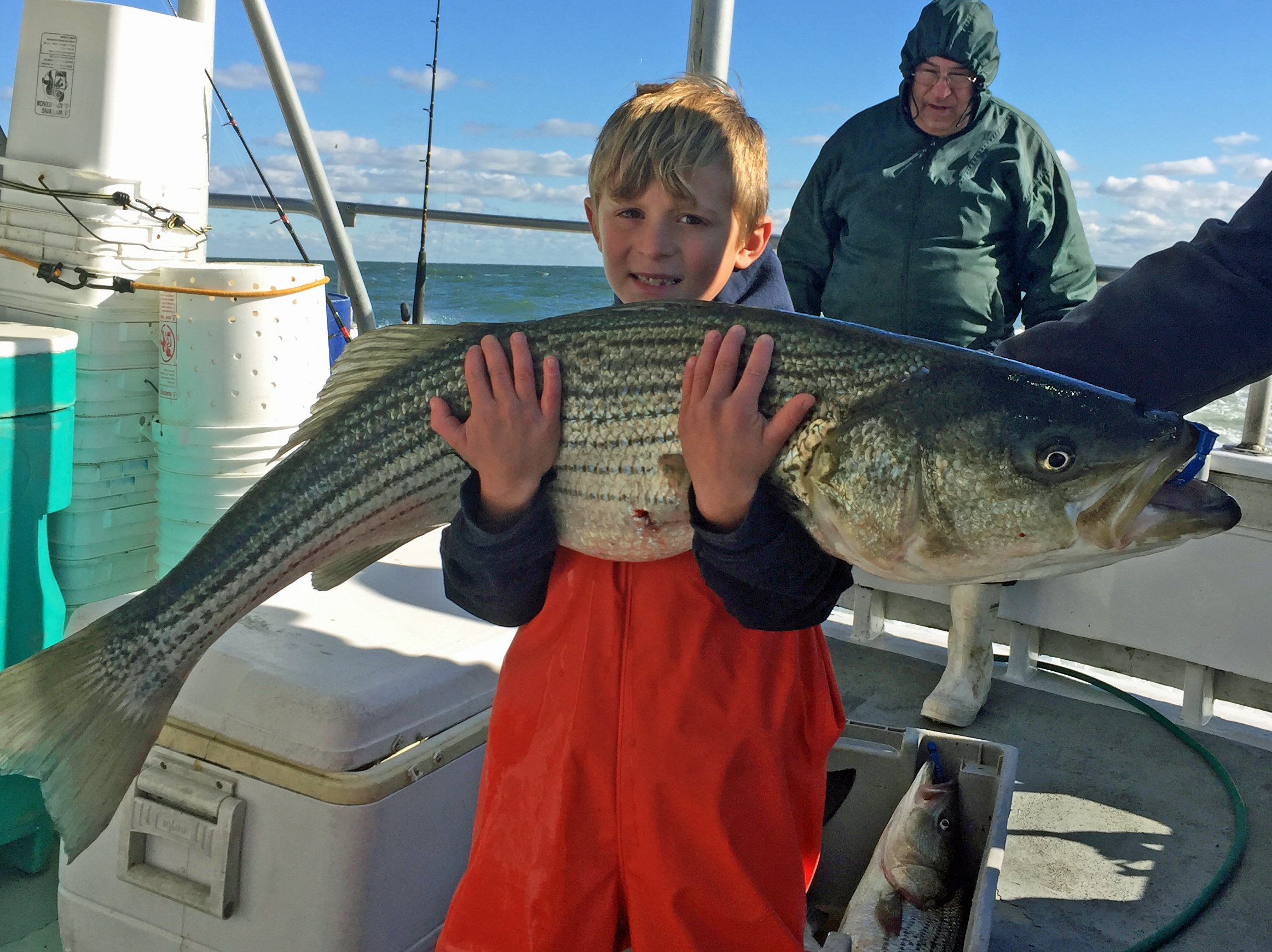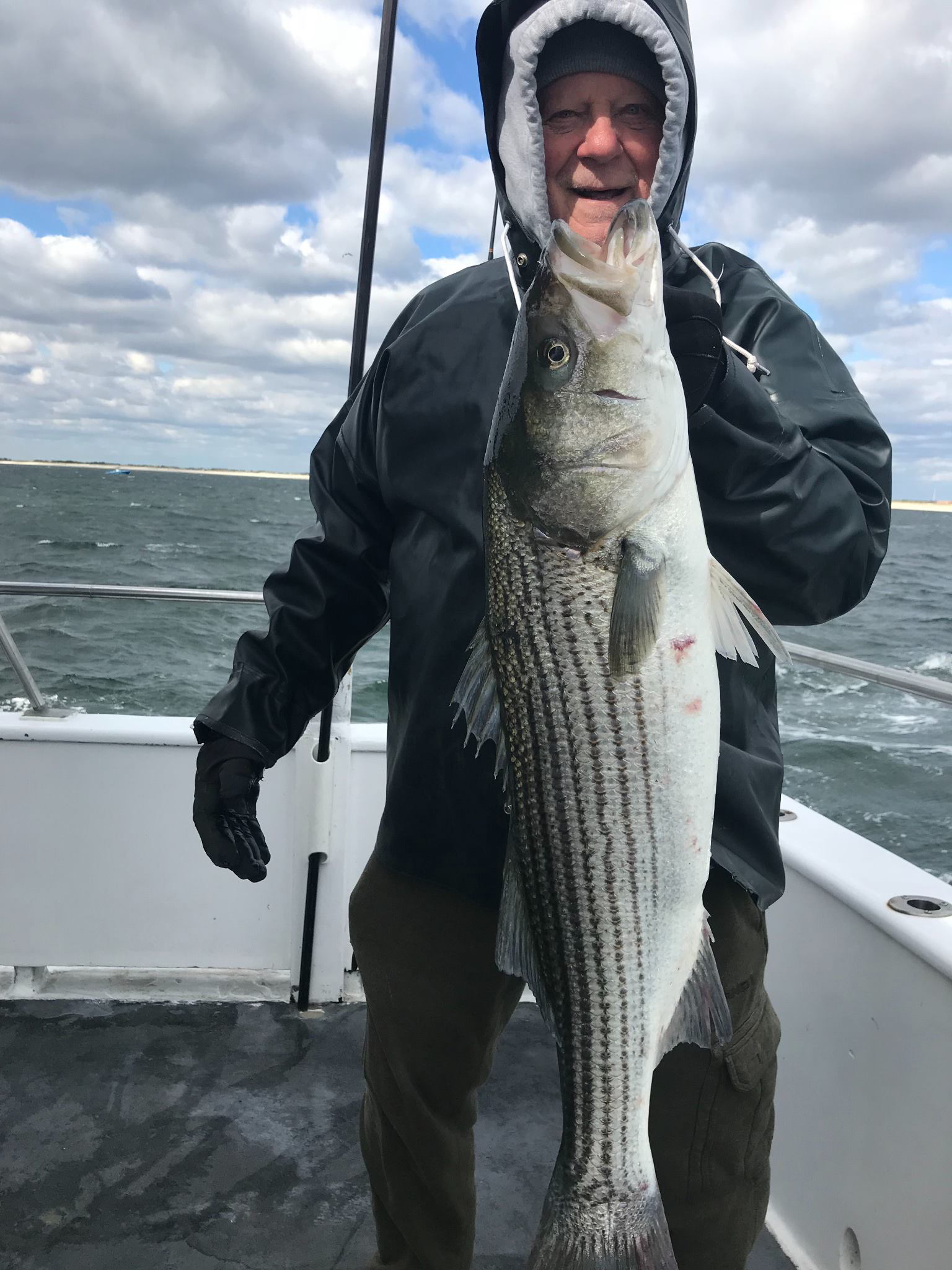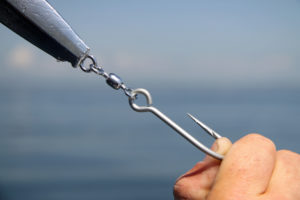CAN’T BEAT THE DIAMONDS!

Party boating offers a way to get in on this fun for those without boats or vessels already in winter storage. This lad decked a linesider he’ll never forget aboard the open boat Captree Pride. Photo of CaptreePride.com.
The legendary fall run of stripers and blues that slides from Cape Cod all the way down to southern New Jersey each November offers some of the most exciting fishing of the year. Many anglers think of this blitz action as a surf gig but drift over the clouds of sand eels and bay anchovies sliding through 50- to 80-foot depths with a diamond jig and you’ll quickly discover the boat fishing is fantastic, too.
Unfortunately, many boaters have pulled their vessels for the winter by this point, so they miss out completely on this fabulous near-shore run. That’s too bad, since the action tends to peak around Election Day and may last through Thanksgiving and into December given a warm fall. If you’ve got the horses to get there, hold off on that shrink wrap order for another couple of weeks. If you do put up in dry dock, you can still join this fun by boarding a local party or charter boat. They’ll make the run and stay on these fish for as long as the action holds together. For small boat skippers, that may be a good idea even if you are is still in the water because stiff and chilly winds this time of the year are a factor that must be recognized.

You may need to dress warm for fall run stripers but the thrills are certainly worth the effort. Photo courtesy of the open boat Captain Gillen, Captree, NY.
FIRE ISLAND IS BLITZ CENTRAL
Whether you pay to play or take your own vessel, figure Fire Island Inlet on Long Island’s south shore to be the center of this action in early November. From here, the main body of fish may slide a bit east toward Moriches Inlet or west toward Jones Inlet at a moment’s notice, so there are times when you’ll need to head out in search mode. This is especially true after several consecutive days of strong winds pushing from the east. As a general rule, if the bass and blues thin out after several consecutive days of strong catches, the baitfish have probably shifted one way or the other so start your search in the direction of the prevailing winds. Relocate the bait and the predators should be nearby. The same logic follows as the center of both the bait and predatory schools steadily shifts to the west toward Jones Inlet, Debs Inlet, across the New York Bight to Sandy Hook and down the Jersey shore.
Of course, not every day brings lock and load action. Just as in any other kind of fishing, many factors influence success. For example, a passing cold front may cause the bait, bass and blues to slip into deeper water while warming trends often lure them toward shallower depths. Expect the most consistent catches to occur in 40- to 80-foot depths, but don’t be afraid to make adjustments if that action fails to materialize.
Keep in mind, also, that bass and blues are usually sight feeding when locked on sand eels and anchovies. Thus, when the water is discolored by storms or strong winds, the bite tends to drop off. In this instance, scout for clear water. If you can locate a distinctive break where underwater visibility improves by a few feet, expect both bass and blues to be stacked right along the edge.
One last thought on finding the fish: if you are catching a few, but they seem skittish, steam away from the fleet. With a mix of party, charter and private vessels jockeying for position over the schools, sometimes striking out on your own to find less pressured pods can pay big rewards.
IT’S A BLING THING

The author favors gold diamond jigs on cloudy days and in discolored water. He likes silver jigs for bright, sunny days. Photo by Tom Schlichter.
Because the bait that bass and blues key on in this run is slender, flashy and thin in profile, diamond jigs are the primary choice for hooking up. These metal slab lures mimic all of these characteristics and get to the bottom quickly. Additionally, when several anglers are working them at the same time, the jigs look like a small pod of baitfish cutting through the water – a sight that bass and blues have a hard time passing-up.
Another great trait of diamond jigs is that they are practically indestructible. Simply put a stone to the hook point now and then to keep it sharp and you are ready to go. These lures can withstand a beating from the crushing jaws of big bass and toothy gator blues. True, they’ll come away with tooth marks scraped through the finish now and then, but that just breaks up the flash making well-worn diamonds even more attractive.
Setting up for battle is fairly straight forward. Choose a sturdy conventional outfit spooled full of 30-pound test mono or 50- to 65-pound test braid and set the drag a little on the tight side so you can drive home the point without any doubt. Attach a 40-inch length of 40- to 50-pound test mono or fluorocarbon leader to the main line with a black barrel swivel and secure the diamond jig to the opposite end. Use a clinch knot to attach the jig if you want a tight, wiggling action that turns on the blues, or use a Palomar knot if you want the lure to have a bit more breath to its swing – a good idea on days when bass dominate or the bite seems a little slow. Either way, choose a “naked” jig (no tube tail). Double-check the drag and you are read to go.
SLOW FOR BASS, FAST FOR BLUES
The majority of fish you’ll hook with these setups will be holding close to the bottom, so it is important to select a jig with enough weight to get down fast. Still, you don’t want a lifeless slab that is too heavy to flutter in the current, so choose a diamond that will register a light tap as opposed to a heavy thud each time it strikes the sea floor. Typically, that means a jig weighing 4 to 6 ounces.
As for the retrieve, fast and furious cranking tends to trigger smashing strikes from bluefish while bass are more apt to slam something moving at half speed. Allow your jig to free-fall to the bottom, engage the reel and crank up six to eight turns before repeating the process again and again until you either set the hook or need a break.

A sharp, single hook is what you need to really stick it to bass and blues during the near-shore fall run. Photo by Tom Schlichter.
I’ve found silver sided diamonds work best in bright, clear water under sunny skies while gold slabs catch best under cloudy skies in slightly discolored water. I generally like silver jigs to have a smooth, highly reflective surface but prefer a hammered finish on gold diamond jigs. Single hook versions make unhooking the catch easy and, I think, present a streamlined profile that most closely resembles the swimming action of sand eels. They are also less prone to stick an angler while the prize is being unhooked.
Whether you fish off Massachusetts, Rhode Island, New York or New Jersey, the south side bass and blue diamond jig blitz should be hitting full stride over the next few weeks. Get out as soon as local fishing reports confirm the fish are chewing in your area, because there is always the possibility that a strong storm or series of sharp cold snaps might curve the migration further offshore bringing the action to an abrupt end. Otherwise, you can expect the bass and blues to be out there prowling the 50-foot line while awaiting your offerings. Dress warm and go get ‘em.
By Tom Schlichter
Use the LIKE button below to get notifications about new articles in your Facebook news feed!



